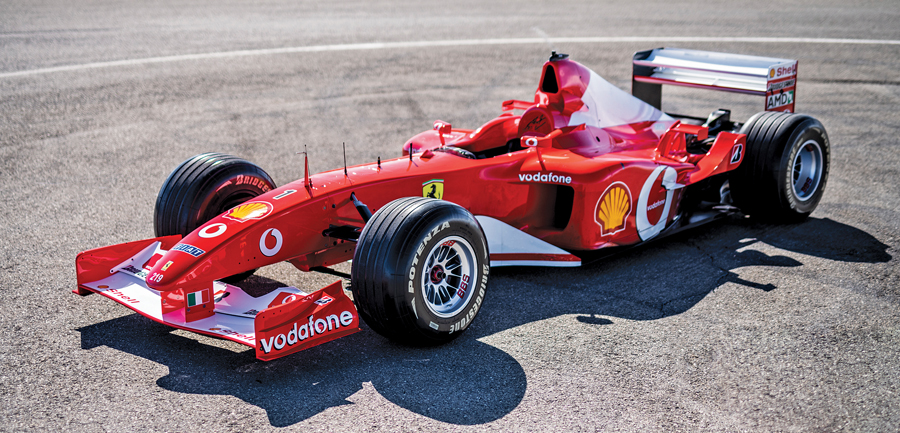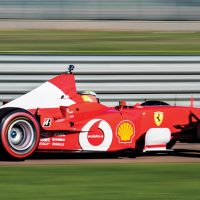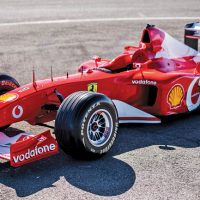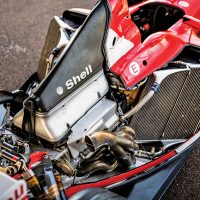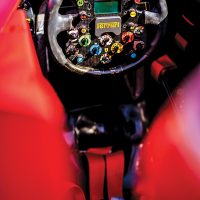SCM Analysis
Detailing
| Vehicle: | 2002 Ferrari F2002 |
| Years Produced: | 2002 |
| Number Produced: | Eight |
| Original List Price: | N/A |
| SCM Valuation: | $6.6 million (this car) |
| Chassis Number Location: | Inside cockpit on left side |
| Engine Number Location: | Back of block |
| Club Info: | Ferrari Owners Club |
| Website: | http://www.ferrariownersclub.org |
| Alternatives: | 1976 Ferrari 312T2, 1992 Williams FW14B, 1994 Ferrari 412T2 |
| Investment Grade: | A |
This car, Lot 117, sold for $6,643,750, including buyer’s premium, at RM Sotheby’s Abu Dhabi, UAE, sale on November 30, 2019.
In all of the car-collecting world, I doubt that there is a market as widely ranging, complex, vexing, and often just plain arbitrary as Formula One racers.
Fabulous, exciting, dependable and competitive vintage racers can be found for well under a million dollars, while similar ones can sell for 10 times that.
Even within Ferraris — a far more collectible marque than, for example, Benetton or even Lotus — a 1994 412T2 can struggle to find a buyer at $1.54 million, while within a few months of that, our subject Ferrari 2002 brought over $6.6 million. The 412T2 is just as red, just as swoopy, within the constraints of who is driving it just as fast, and one heck of a lot more user-friendly than the F2002. What gives?
There are probably reasonable answers to this, but making sense will require a review of what buyers seem to be looking for in old Formula One cars and a quick wander through roughly 50 years of Ferrari backstory.
Who buys a Formula One car?
The basic motivations of people who buy Formula One cars are simple enough: fun, glory and ego. Fun is the desire to participate in the thrill and adrenaline rush of actually driving cars that were in their respective times the absolute pinnacle of the racing experience. This is the “weapons grade” side of the hobby and by far the easiest and least expensive to fulfill: There are literally hundreds of 10- to 50-year-old Formula One cars out there, any one of which is far more capable of going fast and delivering excitement than 95% of the people who aspire to drive them can even think about.
Glory winnows the field substantially insofar as it refers to those cars that actually won Championship races over the years.
In an earlier F1 profile, I noted, “An interesting factor is history: The most iconic Formula One car is not considered particularly collectible unless it has won at least one GP (and, of course, the more wins the better), a weird but almost inviolable constraint.”
As we shall see, this rule has a particular impact on Ferrari F1 values.
Ego is a more complicated issue, but it can have an inordinate effect on prices, particularly when the topic is Ferrari, clearly the highest-status marque in the automotive world.
Economist Thorstein Veblen observed that, for certain extremely wealthy people, the normal cost/benefit tradeoff gets reversed and higher price actually increases desirability. The current snark term for this is “Veblen goods,” but it is a very real and important component of the pricing structure for high-status and very rare racers like our subject.
Ferrari domination?
It’s time to talk about Ferrari. The image of the “Cavallino Rampante” sundering all who dare to challenge it in the racing world is wonderful fantasy, but the reality is that in Formula One over the past 50 years, Ferrari was only occasionally even a major competitor, much less the dominant force that mythology demands. There really weren’t that many winning seasons.
There are lots of reasons for this, many intertwined with the very character that makes Ferrari so iconic.
Between the monomaniacal ego and drive of Enzo Ferrari and the national expectations of being “Italy’s team,” Ferrari could never do it the easy way. As a complete manufacturer, they felt obligated to conceive, design and build every component internally.
Design was frequently based more on romantic ideals (Ferraris should be 12-cylinder) than on clear-eyed pragmatism. They were also, certainly before the merger with Fiat and the introduction of major outside sponsorship in the 1970s, chronically underfunded and technically overcommitted.
Their competition through most of the late 20th century took a different path.
Cosworth created a fantastic racing engine in their DFV and were happy to sell it to anyone, while Hewland built a series of excellent transaxles that were also easily available. The result was a series of English “Garagiste” racing teams that could spend their resources on innovative chassis, suspension and aerodynamics rather than engines. Though Ferrari sneered at these upstarts, the reality was that it was at a huge disadvantage and podium finishes were sparse.
Collectible Formula One Ferraris
For all the hype and excitement about Ferrari Formula One, there are really only three series that meet the serious collectibility criteria. The “Spaghetti Exhaust” 3-liter V12 cars of the late 1960s really weren’t all that successful, but they are so gorgeous and exotically complex that they override lesser considerations. Plus, if you want to be top dog at the Monaco Historic GP, that’s what you need to have.
In the mid-to-late 1970s, Ferrari managed to really get its act together with the flat-12 312T series of racers. Combined with Niki Lauda and Clay Regazzoni’s sensational talents, Ferrari managed a hat trick of three successive championship seasons, and those cars have become immensely valuable.
There is a rumor that the best of these cars might be available for €10 million. An excellent one sold at Monterey this summer for $6 million. These cars have the advantage of being easy to drive, maintain and race. You don’t need Ferrari’s help to run them.
The third group of highly collectible F1 Ferraris is the 3-liter V10 cars of the Schumacher era.
In his 10 years at Ferrari (1996–2006), Michael Schumacher became the most successful driver in the history of the sport, winning five consecutive world championships for Ferrari, and every car that he drove has become an object of veneration for a particular group of collectors.
Interestingly, the core of these collectors are from Asia, mostly Japanese with some Chinese, immensely wealthy, and unafraid (even proud) of big numbers. Mike Sheehan tells me that there are probably not more than 10 or 15 of them, but they are intensely involved and they both create and drive the market.
Ferrari built about eight cars a year for the 10 years of the era, so there are roughly 80 suitable racers out there, and they don’t come available often.
This is a narrow, niche market
When these Ferrari racers do hit the market, it creates a bit of a feeding frenzy among those who care.
The important thing to remember is that this is a very specific niche market and doesn’t represent anything in the larger collector-car market, or even in the Ferrari F1 category. This was a very special example of a car which is very important to a very few, very wealthy players and sold accordingly.
It’s an ego piece that will grace somebody’s automotive plumage. It can be driven, but only for a few laps at great expense by someone who is a far better driver than most. The players here make their own market. I’ll have to assume fairly bought.
